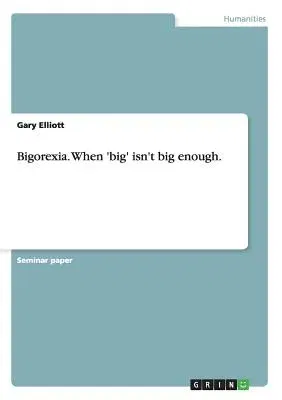Seminar paper from the year 2010 in the subject Psychology -
Miscellaneous, ( Atlantic International University ), language: English,
abstract: The term 'bigorexia nervosa', along with another synonym
'reverse anorexia', are nicknames for muscle dysmorphia. Muscle
dysmorphia is deemed to be a sub-type of body dysmorphic disorder. It is
seen primarily in men who usually perceive themselves as puny, or not
muscular enough. The man or boy with muscle dysmorphia is bombarded with
obsessive thoughts that their muscles aren't big enough and feel small
and weak, even though, in many cases, they may actually have large,
strong muscles. The Diagnostic and Statistical Manual of Mental
Disorders, fourth edition (DSM-IV) describes body dysmorphic disorder
(BDD) as a preoccupation with a defect in appearance. The defect is
either imagined or minor, but if a defect is present, the individual's
concern about the defect is markedly excessive in comparison with the
severity of the defect (Claiborn & Pedrick: 2002). Sufferers of Muscle
Dysmorphia, like others with BDD, see parts of their body as defective.
This excessive preoccupation with body size and muscularity causes the
sufferer to feel small when they're actually big. In Paterson (2008),
muscle dysmorphia is defined as a syndrome seen in both men and boys who
feel dissatisfied with their bodies; not believing they are muscular
enough. Morgan (2008) explains that at the 'root' of muscle dysmorphia
is a distortion of body image. Body dysmorphia occurs almost exclusively
in males and is a condition that consists of believing that one cannot
be big enough (Andersen et al: 2000). In the Psychology Today magazine
of 1997, it was reported that 43% of men interviewed were dissatisfied
with their overall appearance; this is a dramatic increase form 15% in
1972 and 34% in 1985; so much so that Claiborn & Pedrick (2002) suggest
that male body image dissatisfaction is catching up with that of women.
Andersen et al. (2000) purpo


